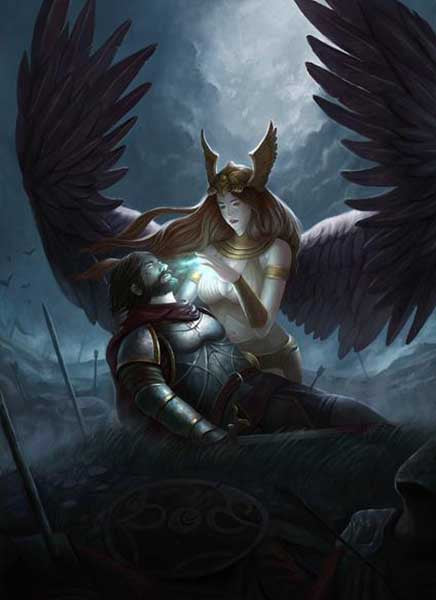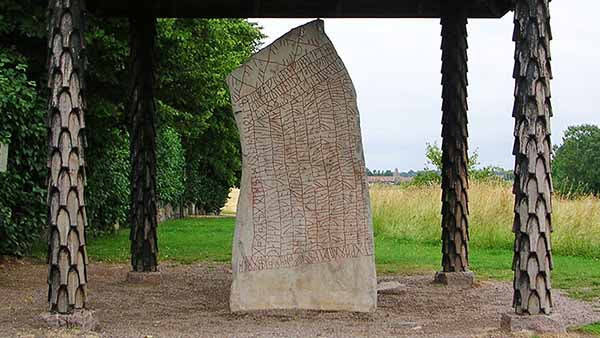🚚 Free shipping on orders over $60 + 10% off with code VIKING10
🚚 Free shipping on orders over $60 + 10% off with code VIKING10
Valkyries
October 27, 2023 7 min read

The Valkyries | The Astonishing Story of Viking Warrior Women!
The Valkyries are the most well-known Norse mythological warrior goddesses. They have always been one of the greatest emblems of the Viking people, serving as one of the sacred symbols of Norse beliefs. Just like the most eminent gods of the Norse pantheon, the Valkyries have fueled numerous myths and legends.
Fearsome in war, loyal, proud, and powerful, the Valkyrie epitomizes Viking civilization. According to some myths, she is the mystical source of the legendary strength of the Vikings, especially of Scandinavian women.
In this article, we will uncover the history and origin of the Valkyries, the warrior women who forged the myth of the Vikings and the most powerful fighters in Europe. You will understand the extent of the influence of one of the greatest figures of Scandinavian civilization.
The Valkyries or Walkyries: A Symbol of Viking Civilization

In modern culture, Valkyries are often depicted as elegant women formidable in battle. Adorned in sparkling armor and golden helmets, they wield spears and ride divine winged mounts called Pegasus.
This representation is the most widespread image of the Valkyries. However, it only represents a small part of what these exceptional beings truly were, as this popular image is largely based on paintings and works that date well after the Viking Age.
A typical example is the poem "Darraðarljóð”, written in Old Norse and describing a battle that took place in 1014, long after pagan beliefs had been swept away by Christianity. Similarly, there are works engraved on church pillars that testify to their existence.
Nevertheless, it is accepted that the Valkyries were omnipresent throughout Scandinavian history and are the subject of numerous Norse myths. They are believed to be associated with the folkloric legend of the “Swan Woman”, also found in other civilizations, dating back to 30,000 BC. Tapestries venerating the Valkyries from the Viking era also prove their importance within the Scandinavian people.
To understand the special place they occupied, one must delve into the roots of Scandinavian legends.
The Origin of the Valkyries: The Legend of Viking Women
In Scandinavian mythology, the pantheon of Norse deities is divided into 3 major families:
- The Aesir: the most powerful family of gods, ruling over the realm of Asgard. Their sovereign is none other than Odin, the Allfather, father of all gods and creator of the world;
- The Vanir: deities from Vanaheim. They waged a long war against the Aesir, which eventually ended in a mutual agreement;
- The Disir: meaning “ladies” or “goddesses” in Old Norse. These are strictly female deities, including the Valkyries.
The Valkyries are Disir serving the god Odin and Asgard. They will fight alongside him during the great war of Ragnarök. Hence, one of the meanings of their name is: “The Disir who faithfully serve Odin”.
Valkyrie and Viking Warriors

In Norse mythology, the most valiant warriors had the honor of being welcomed into Valhalla, the famous banquet hall of Odin. The Vikings have an unbreakable bond with this sacred god, who was simultaneously the god of protection, strength, and death.
Odin would send his most loyal Valkyries to the battlefields to:
- Decide which warriors would partake in the final battle, and consequently, who would have the great honor of dying in combat. Their blessing fell upon the bravest Vikings;
- Protect the Viking warriors, give them strength and courage, and thus enable them to achieve the most glorious victories against their adversaries. Indeed, the Valkyries did not just watch over the battles. They had the curious power to influence the course of a war in favor of one side or the other;
- Select the greatest Viking warriors who would be welcomed into Valhalla to fight alongside Odin during Ragnarök against Loki and the ice giants. The souls of noble warriors who died in battle are escorted by the Valkyries to Asgard to become Einherjar: warriors unafraid to fall in battle.
The Meaning of Valkyrie or Walkyrie

Due to the very mysterious origin of the Valkyries, their name carried a multitude of meanings. However, it has always been related to Odin:
- In Old Norse : Val means “those who died in battle” and kyrie derives from the verb “kjósa,” meaning “to choose.” Thus, valkyrie can be translated as: she who decides which warriors will perish in battle.
- Oskmær or Odin’smeyjar : meaning “maidens blessed by Odin” or “sacred daughters of Odin.” This name was given to certain warrior women born of mortal parents, who were raised to the status of goddesses by Odin himself.
These Viking women were such powerful fighters that Odin honored them with the title of war goddess “Valkyrie.” This title also signifies the purity of these women, as they are most often described as virgins.
These Viking women were such powerful fighters that Odin honored them with the title of war goddess “Valkyrie.” This title also signifies the purity of these women, as they are most often described as virgins.
The Skjaldmös: The True Valkyries

Viking sagas attest to the existence of female warriors who led great battles, referred to as Skjaldmös. These numerous stories and tales from various Germanic and Scandinavian peoples are believed to be the origin of the legend of the Valkyries:
- The Saga of “Hervor” and King “Heidrekr”: This Icelandic saga tells the story of a warrior princess Hervor. To fulfill her quest, she unearths a powerful sword forged by dwarves and cursed with a spell: the Tyrfing sword. She emerges victorious from her battle, but at the cost of a curse that will claim her life.
- The GestaDanorum: This recounts the events of a legendary 8th-century war between Denmark and Sweden: the Battle of Brávellir. More than 300 Skjaldmös fought in the ranks of Denmark, including the legendary “Webiorg,” a mythical Scandinavian warrior.
- The Grœnlendinga saga: This tells the story of “Freydis Eiriksdottir,” the daughter of the famous Norwegian explorer, Erik the Red. During an expedition to Vinland (North America), she single-handedly faced a group of Native Americans, who fled in the face of her courage and bravery.
These legendary women were the origin of myths that depict the power of the Valkyries. Women of iron will, compared to war goddesses, whom nothing and no one could shake.
The Valkyries and the Norns
The Valkyries and the Norns are often confused in Norse mythology, as their skills and abilities are similar and almost identical. The three Norns: Verdandi, Urd, and Skuld weave the fate of every being on the Yggdrasil tree, including that of the gods.
The Valkyries can control the fate of warriors and decide who will perish. It is often difficult to distinguish between their power and that of the Norns. “Skuld,” whose name means “she who sees the future,” is particularly mentioned or compared, on several occasions and in different sagas, to a Valkyrie.
The Rök Stone: The Hidden Meaning of the Valkyries

An ancient Icelandic runic text, engraved on a stone called “The Rök Stone” or “Rökstenen,” describes the Valkyries as fierce and bloodthirsty warriors. This is a far cry from the image of them riding the graceful Pegasus often found in modern culture.
This Nordic text depicts them as ruthless war goddesses:
- Their mount is a bloodthirsty wolf: a formidable combat companion that roams the battlefield in search of the bodies of the noblest Viking warriors;
- The omniscience of the raven: Odin has given them the power to perceive everything that happens during battles and report it back to him;
- They decide the fate of warriors: if a warrior is exceptional, they can cause his premature death in battle to take him to Valhalla and strengthen Odin's army. This is why some Viking warriors do not look up to the sky, so the Valkyries do not notice them.
These raven-eyed Viking warriors, riding a horde of wolves, actually embody the power of the father of gods through his two symbols:
- The wolves “Geri” and “Freki”: formidable companions in battle, they have fought in countless wars alongside the god Odin. During his expeditions to the ends of the 9 worlds, he leaves them to guard his throne, which no one dares approach;
- The ravens “Hugin” and “Munin”: “Hugin” means “spirit” and “Munin” means “memory”. Every day they fly over the nine worlds and report back to Odin everything they have seen and heard.
These two animals with divine abilities are mentioned repeatedly in Norse mythology. The Valkyrie represents the perfect balance between the two. Merciless in war like the wolf, she forms the link between the world of the dead and the living. With the wisdom of the raven, she holds the privilege of deciding the fate of warriors.
The Most Famous Valkyries
Norse mythology includes the stories of many Valkyries. They played a central role in this civilization. Whether through their sacrifice or their bravery, three Viking warriors are at the origin of the most legendary myths:
1 – The Original Valkyrie: The Goddess https://www.vikingheritage.net/blogs/viking/freya

The first of the Valkyries, and undoubtedly the most powerful, is none other than the goddess Freya. The famous goddess of love, beauty, and fertility, is also a war goddess. She fought alongside the Vanes in the conflict against the Aesir.
To end this endless struggle, hostages had to be exchanged between the two clans. Freya, being an invaluable asset to Odin's opposing camp, was one of them. However, her abilities and charm quickly promoted her to the rank of an Aesir goddess.
Freya, the Valkyrie goddess, became equal to the god Odin on the battlefield, and led all other Valkyries. She chooses first half of the most valiant warriors and welcomes them to her palace, “Sessrumnir,” located in the realm of “Fólkvangr.” The other half is then escorted by the Valkyries serving Odin to Valhalla.
The goddess Freya rarely wore armor or weapons. However, she possessed attributes with immeasurable powers:
- The Brisingar necklace: this Viking necklace makes Freya's charm almost irresistible. It gives her the ability to influence the outcome of a war by favoring one side over the other;
- Freya's chariot: it is pulled by two giant cats gifted to her by Thor. Like Odin's wolves, cats are Freya's sacred animals;
- The Valshamr cloak: a falcon feather cloak that allows her to transform into a bird. Only women can use it.
In addition to these gifts, Freya masters divine magic, “Seidr”, which allows women who use it to see the fate of people and change the course of future events to their advantage.
2 – Lagertha: The Wife of the Legendary Ragnar
The legend of this Viking skjaldmö is told in “Gesta Danorum,” a book that traces the history of Denmark. The legendary Viking king Ragnar Lodbrok was impressed by the courage and bravery of Lagertha, despite her young age at their meeting.
She led Ragnar to victory and glory, and came to his aid with a fleet of more than 120 ships when he was surrounded by enemies. She became very popular following the broadcast of the television series “Vikings”.
3 – Brunehilde and Sigurd: Legendary Scandinavian Heroes
The Völsunga saga and Snorri's Edda tell the story of the legendary Valkyrie Brunehilde and her husband, the legendary hero Sigurd. They embark on numerous adventures and journeys to be reunited, even defying the god Odin.
Leave a comment
Comments will be approved before showing up.




